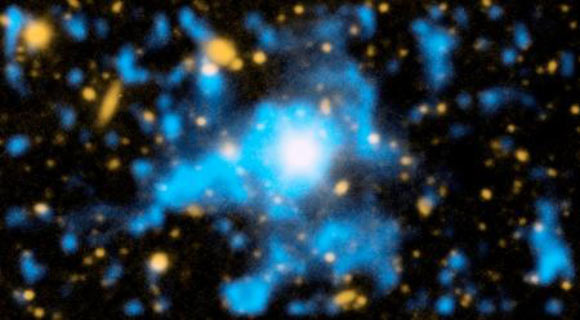An international team of astronomers using the Palomar Cosmic Web Imager has captured stunning images of the intergalactic medium – the diffuse gas that connects galaxies throughout the Universe.

This image, with taken with the Palomar Cosmic Web Imager, shows the quasar QSO 1549+19; blue shows hydrogen gas surrounding and inflowing to the quasar. Image credit: Christopher Martin / Robert Hurt.
Since the 1980s, scientists have predicted that primordial gas from the Big Bang is not spread uniformly throughout space, but is instead distributed in channels that span galaxies and flow between them.
This ‘cosmic web’ is a network of smaller and larger filaments crisscrossing one another across the vastness of space and back through time to an era when galaxies were first forming and stars were being produced at a rapid rate.
Prior to the development of the Palomar Cosmic Web Imager, the intergalactic medium (IGM) was observed primarily via foreground absorption of light occurring between Earth and a distant object such as a quasar.
The first filaments observed by the astronomers are in the vicinity of two very bright objects: the quasar QSO 1549+19 and a so-called Lyman alpha blob in the emerging galaxy cluster SSA22.
These objects date to about 2 billion years after the Big Bang, a time of rapid star formation in galaxies, and were chosen by the team for initial observations because they are bright, lighting up the surrounding IGM and boosting its detectable signal.
Observations show a narrow filament, about 1 million light-years long, flowing into QSO 1549+19, perhaps fueling the growth of the galaxy that hosts the quasar.
Meanwhile, there are 3 filaments surrounding the Lyman alpha blob, with a measured spin that shows that the gas from these filaments is flowing into the blob and affecting its dynamics.
“In the case of the Lyman alpha blob. I think we’re looking at a giant protogalactic disk. It’s almost 300,000 light-years in diameter, three times the size of the Milky Way,” said Prof Christopher Martin from the California Institute of Technology’s Cahill Center for Astrophysics, the lead author of two papers published in the Astrophysical Journal (paper 1 & paper 2).
“The gaseous filaments and structures we see around the quasar and the Lyman alpha blob are unusually bright. Our goal is to eventually be able to see the average intergalactic medium everywhere. It’s harder, but we’ll get there.”
______
Martin DC et al. 2014. Intergalactic Medium Emission Observations with the Cosmic Web Imager. I. The Circum-QSO Medium of QSO 1549+19, and Evidence for a Filamentary Gas Inflow. ApJ 786, 106; doi: 10.1088/0004-637X/786/2/106
Martin DC et al. 2014. Intergalactic Medium Emission Observations with the Cosmic Web Imager. II. Discovery of Extended, Kinematically Linked Emission around SSA22 Lyα Blob 2. ApJ 786, 107; doi: 10.1088/0004-637X/786/2/107







